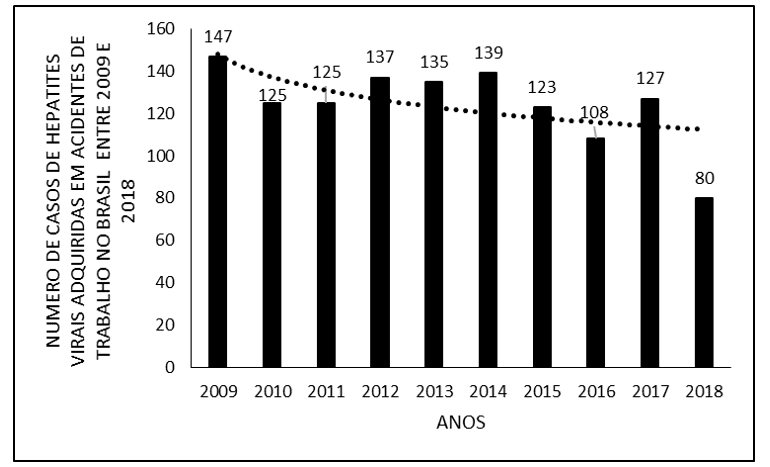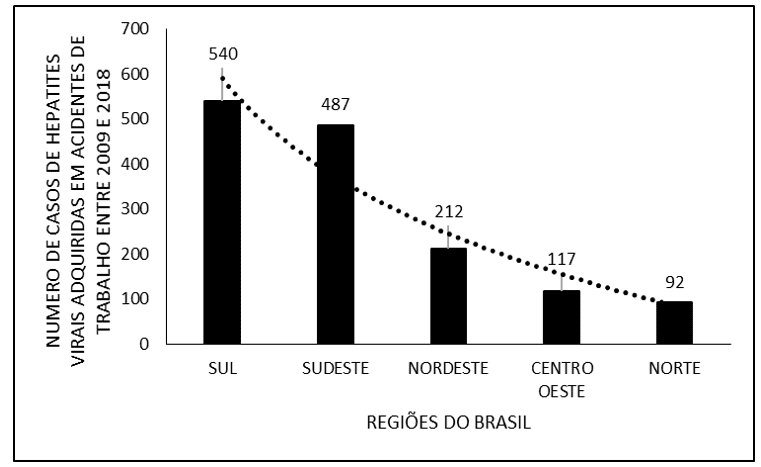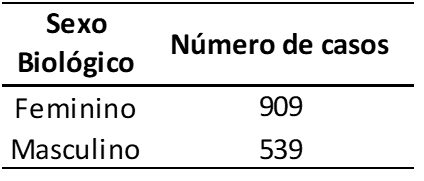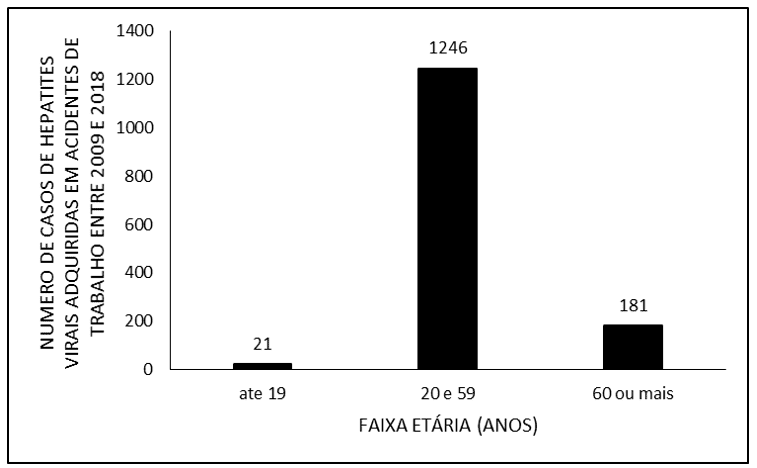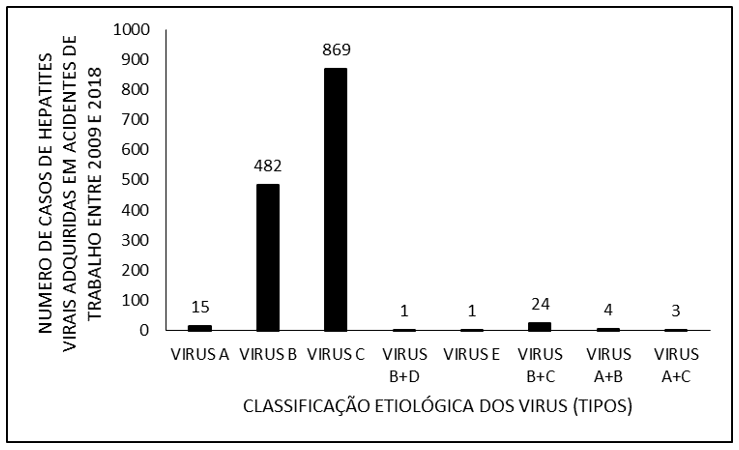ORIGINAL ARTICLE
ALMEIDA, Naara Perdigão Cota de [1], LIMA JÚNIOR, Idelbrando Araújo [2], AZEVEDO, Lucas do Rêgo Góes [3], MARTINS, Romulo Maia [4], MAGALHÃES, Gustavo Aurélio Linhares [5], DIAS, Claudio Alberto Gellis de Mattos [6], ARAÚJO, Maria Helena Mendonça de [7], OLIVEIRA, Euzébio de [8], DENDASCK, Carla Viana [9], FECURY, Amanda Alves [10]
ALMEIDA, Naara Perdigão Cota de. Et al. Number of cases of hepatitis acquired in occupational accidents in Brazil between 2009 and 2018. Revista Científica Multidisciplinar Núcleo do Conhecimento. Year 05, Ed. 12, Vol. 10, pp. 28-37. December 2020. ISSN: 2448-0959, Access link: https://www.nucleodoconhecimento.com.br/health/cases-of-hepatitis, DOI: 10.32749/nucleodoconhecimento.com.br/health/cases-of-hepatitis
SUMMARY
Viral hepatitis is a serious public health problem in the world and in Brazil. These are diseases of compulsory notification instituted by the Brazilian Ministry of Health (MS). The records of the affected persons should be made in the Notifiable Diseases Information System (SINAN), which should notify all probable cases, confirmed and outbreaks. The objective of this work is to quantify the number of cases of hepatitis acquired in occupational accidents in Brazil between 2009 and 2018. It is a study is a retrospective observational quantitative analysis of the epidemiological data investigated. In this sense, research was carried out in the databases of the national portal DATASUS (https://datasus.saude.gov.br/). There is an effective contribution of accidents at work to the current incidence rates of viral hepatitis in Brazil, as well as to the reduction of the quality of life of workers – especially those of health. Inconsistencies between epidemiological data recorded in SINAN and studies in the literature may demonstrate the presence of underreporting. Due to the relative scarcity and contradiction of studies, there is no well-established profile for contamination in health services, and there is a need for further studies on the subject.
Keywords: Epidemiology, hepatitis, work accident.
INTRODUCTION
Viral hepatitis is a serious public health problem in the world and in Brazil. Estimates suggest that billions of people have had contact with some type of hepatitis virus and millions of these are chronic patients (BRASIL, 2005). Hepatitis is diseases caused by different etiological agents. They have in common hepatotropism, presenting similar clinical and laboratory characteristics, but with important particularities in the epidemiology of cases (BRASIL, 2016). Despite having a universal distribution it is possible to notice a difference in magnitude of the different etiological agents between countries and even in different regions of the same country, such as Brazil. Certain conditions may predispose to the increase of such diseases, such as poor quality hygiene and lack of basic sanitation. The improvement of these factors, together with new techniques for diagnosing hepatitis C and the expansion of hepatitis B vaccination programs, are important advances to reduce the rates of affected patients (BRASIL, 2016; NUNES et al., 2020).
Viral hepatitis are diseases of compulsory notification instituted by the Brazilian Ministry of Health (MS). The records of the affected people should be made in the Information System of Notifiable Diseases (SINAN), which should notify all probable cases, confirmed and outbreaks (BRASIL PORTARIA 2014, 2016).
Work accidents represent a relevant adverse and aggravating event that occurred in work activities, standing out as a mechanism for contagion of infectious diseases, such as viral hepatitis, with great importance for public health (GARCELL, 2016). Such accidents, in addition to representing importance in public health, have impacts on the lives of victims, which may affect their quality of life and health (BULHÕES, 1998).
In this perspective, workers have in common the profiles of illness and death of the population in general, due to their age, gender, social group or insertion in a specific group of risk. In addition, workers can also fall ill or die from work-related causes, as a result of the profession they have exercised or exercised, or because of the adverse conditions in which their work is, or has been, performed (BRASIL, 2001).
Epidemiological surveillance, in this context, becomes an efficient strategy in the prevention and control of diseases, which can reinforce the idea of self-care and commitment of health professionals in Brazil (Cordeiro et al., 2018). In order to reinforce the program of epidemiological control of hepatitis in Brazil, the MH instituted priority in the DCCI/ SVS/MS for the biennium 2019-2020 of actions in the prevention and fight against viral hepatitis (MS, 2020).
GOAL
Quantify the number of cases of hepatitis acquired in occupational accidents in Brazil between 2009 and 2018.
METHODOLOGY
The present study is a retrospective observational quantitative analysis of the epidemiological data investigated. In this sense, research was conducted in the databases of the national portal DATASUS (https://datasus.saude.gov.br/), referring to notifications of viral hepatitis contamination in work accidents between 2009 and 2018.
Therefore, the analysis parameters included were the number of cases separated per year, the quantification of occurrences in each region of the country, the separation of the contagion occurred between men and women, as well as the distribution of the affected age group and the number of notifications according to the type of hepatitis contaminant virus.
Data were obtained in June 2020. Then the collected data were compiled, then tabulated in the Excel program, component of the Office suite of Microsoft Corporation and finally analyzed in conjunction with the raised literary research.
RESULTS
According to the data specified in Figure 1, among the years investigated, 2009 obtained the highest number of cases of viral hepatitis acquired in work accidents in Brazil, recording 147 occurrences. Already 2018 was the year in which the number of cases was lower, 80. That is, in 10 years, there was a 45.5% decrease in the number of notifications.
Figure 1 – Shows the number of cases of viral hepatitis acquired in occupational accidents in Brazil between 2009 and 2018.
The number of cases of viral hepatitis acquired in registered work accidents varied according to the Brazilian regions analyzed (Figure 2). The South corresponded to the highest number of contaminations, 540. The North to the smallest, with 92 reported cases.
Figure 2 – Shows the number of cases of viral hepatitis acquired in occupational accidents by regions of Brazil between 2009 and 2018.
Regarding the information contained in Table 1, with the case of viral hepatitis acquired in occupational accidents between 2009 and 2018 by biological sex, more than 60% of the contaminations correspond to women, that is, 909 cases, while 539 of the cases correspond to men.
Table 1 – Shows the number of cases of viral hepatitis acquired in occupational accidents, by biological sex, between 2009 and 2018.
Regarding the distribution of cases by age group, between 2009 and 2018 (figure 3), corresponding to contaminationacquired in work accidents, twenty-one (21) of them were acquired under 19 years. One thousand two hundred and forty-six (1246) between 20 and 59 years, representing the range with the highest contamination, considering this being the range that holds the largest number of workers in the country, and one hundred and eighty-one (181) contaminations from the age of 60.
Figure 3 – Shows the number of cases of viral hepatitis acquired in work-related accidents, by age group (years), between 2009 and 2018.
Hepatitis contamination acquired in occupational accidents between 2009 and 2018 varied according to types (ethological classification) (figure 4). Among the notifications made, the types with the highest incidence were C, with 869 cases and B, with 482. The ones with the lowest incidence were type B+D and E, both with 1 case.
Figure 4 – Shows the number of cases of viral hepatitis acquired in occupational accidents, by etiological classification (types) between 2009 and 2018.
DISCUSSION
Viral hepatitis is among the infectious diseases still very prevalent in Brazil and, according to data from the Ministry of Health, there were 718,837 people notified from 1997 to 2018 (BRASIL, 2018). Through the quantitative analysis of these data, it is possible to observe that among regularized workers, health professionals are one of the classes most exposed to contamination by these viruses through accidents in their work environment, and that their causes are potentially preventable according to the work of Vieira et. al. (2011).
Data on the incidence of cases involving viral hepatitis resulting from work-related accidents are in line with other similar analyses present in the work of Spagnuolo et al (2008). Most cases by number of inhabitants are in the southeast and south of the country with about 540 and 487 reported cases, respectively, which can be explained both by the population and professional concentration, as well as by the large number of health services concentrated in this space (CORDEIRO, 2018).
Regarding gender, the most affected is the female sex, since accidents are mostly related to nursing teams, which is confirmed in the work of Santos et al (2013). The Oswaldo Cruz Foundation conducted a survey in 2015, tracing the profile of the nursing team in Brazil, which showed a result of 85.1% of females performing these activities, with this, there is a clear relationship with the high incidence in females (62.7%) found in this study (FIOCRUZ, 2013).
The age group in which there were more cases was 40 to 59 years, which differs from some studies conducted in hospitals in Brazil, in which the most affected age group was younger, under 40 years (SANTOS, 2013; VIEIRA, 2011). The information obtained in DATASUS may be related to the impression that the most experienced professionals have the tendency to give more room for error when performing their procedures due to overconfidence, consequently, no longer pay attention to the fundamental details of individual security (RODRIGUES, 2017).
The most reported type was hepatitis C, according to data researched by DATASUS from 2009 to 2018, since it confirms with some studies in the literature, but also diverges from others that indicate that the most incident form of contamination was hepatitis B. To date, it is not yet well established what is the most incident contamination profile in health services in Brazil (VIEIRA, 2011).
The most common form of accident reported in scientific articles is through the manipulation of sharp-cutting insums causing skin lesions, mainly related to needle stick accidents and disposal of materials in inappropriate locations, the non-use of personal protective equipment (SPAGNUOLO, 2011; CORDEIRO, 2019).The main reasons related to the high incidence of these types of accidents are high working hours, unhealthy conditions, excessive stress in shifts and work environment, as well as low continuing education and updating in the training of these professionals (BARBOSA, 2017).
The measures that should be strengthened are: training and training of multidisciplinary teams, review of injectable application techniques, adoption of safety protocols, acquisition of specialized devices and promotion of safer environments. Percutaneous exposures were the majority, mainly in the upper limbs, and the hands were the most affected site due to the handling of hospital insums and procedures. The high incidence of this type of occupational exposure reinforces the need for continuous surveillance and training on the management of sharp objects (MARZIALE, 2014).
In addition, pre- and post-exposure prophylaxis stands out because it is a widely available alternative, but does not have the desired adherence for a class of professionals with routine risk such as health. A study carried out with 3,084 workers in Bahia showed that only 2,666 were vaccinated and of these, only 59.7% completed the 3 doses of hepatitis B vaccine, which is worrisome since the vaccine is one of the main ways of preventing the disease (SOUZA, 2018).
Work accidents are present in the daily lives of health professionals and are closely related to several modifiable factors such as inadequate training, poor working conditions, lack of basic PPE for good safety and ignorance of prophylaxis protocols before and after exposure to contamination, among others. It was noticed that in Brazil, there is still a considerable amount of underreporting of cases, in addition to few studies that elucidate the real situation regarding this type of accident (SOUZA, 2018).
CONCLUSION
There is an effective contribution of accidents at work to the current incidence rates of viral hepatitis in Brazil, as well as to the reduction of the quality of life of workers – especially those of health. There is also importance of work accidents as a cause for hepatitis infection, and as changes in customs combined with better working conditions can circumvent the current situation in Brazil.
There is a correlation between sanitation conditions and the risk of contamination during the work accident, and therefore the employer must provide safe working conditions. Moreover, because it is a theme always present and necessary, the prevention of work accidents and contamination should always be the target of training and training. Reduced exposure and unhealthy and stress conditions, and safer work environments can also contribute to reducing accidents among health workers.
Inconsistencies between epidemiological data recorded in SINAN and studies in the literature may demonstrate the presence of underreporting. Based on the understanding that compulsory notifications serve as a guide for the implementation of public policies, professionals should be made aware of this need. In this scenario – a possible reduction in underreporting – we will have more real numbers better targeting health education, focused on self-care and accident prevention in the workplace, in addition to the adoption of strategies and protocols that can help in early diagnosis and pre- and post-exposure prophylaxis. *In addition, the inconsistencies and incompleteness found point to the need for more careful completionof the notification forms, in order to be high the quality of SINAN databases.
Special attention should be given to health units and hospital centers in the south and southeast regions, resulting from the high absolute and relative number (number of professionals/inhabitants) that they have and who are exposed to this risk.
Because work accidents are preventable, measures to prophylaxis for viral hepatitis infection are necessary, either by continuous training on correct techniques for handling and disposal of contaminated materials or by more effective control of the working hours of health professionals by managers. Special care should be taken for those professionals with older training and older age, who usually have a lot of confidence in their skills, while they have a gradual reduction of reflexes and motor coordination. Refreshant and awareness courses are essential for groups.
Because perforating tools are the most recurrent instruments in occupational accidents involving infection by viral diseases and because the hands are the most common place of contamination in such accidents, there is a need for due caution and the use of EPIs by professionals, in addition to the use of the correct technique in its handling and disposal in an appropriate place. For this, managers should promote training and awareness, as well as a place and material suitable for the disposal of sharps. In addition, there is a need for actions that increase the professional’s support for pre- and post-exposure prophylaxis measures, such as the requirement to prove vaccination schemes by health units.
Due to the relative scarcity and contradiction of studies, there is no well-established profile for contamination in health services, and there is a need for further studies on the subject. Further epidemiological studies are needed, in addition to quality control of these and the reduction of underreporting with improvement in the quality of filling out compulsory notification forms.
REFERENCES
BARBOSA, Adriana Sierra Assencio Almeida, DIOGO, Geandra do Amaral, SALLOTI, Selma Regina Axcar, SILVA, Sônia Maria Usó Ruiz. Subnotificação de acidente ocupacional com materiais biológicos entre profissionais de Enfermagem em um hospital público. Revista Brasileira de Medicina do Trabalho, 2017, 15(1), 12-17, 11 de maio de 2017. Disponível em: http://www.rbmt.org.br/details/209/pt-BR/subnotificacao-de-acidente-ocupacional-com-materiais-biologicos-entre-profissionais-de-enfermagem-em-um-hospital-publico. Acesso em 03/09/2020.
BRASIL. Ministério da Saúde. Secretaria de Vigilância em Saúde. Departamento de Vigilância Epidemiológica. Hepatites virais: o Brasil está atento, 2ª edição. Brasília: Ministério da Saúde, 2005. 40 p.
BRASIL. Ministério da Saúde. Secretaria de Vigilância em Saúde. Departamento de Vigilância, Prevenção e Controle das Doenças Sexualmente Transmissíveis, Aids e Hepatites Virais. Manual Técnico para o Diagnóstico das Hepatites Virais, 2ª edição. Brasília: Ministério da Saúde, 2016. 123 p.
BRASIL. Ministério da Saúde. Define a lista nacional de notificação compulsória de doenças, agravos e eventos de saúde pública nos serviços de saúde públicos e privados em todo território nacional, nos termos do anexo, e dá outras providências. Portaria nº 204, de 17 de fevereiro de 2016. Brasília: Diário Oficial da União. 2016; Seção 1 (32): 23-4.
BRASIL. Ministério da Saúde. Secretaria de Vigilância em Saúde. Coordenação-Geral de Saúde do Trabalhador. Desigualdades no Mercado de Trabalho e Perfil de Adoecimento das Mulheres Trabalhadoras Brasileiras. Boletim Epidemiológico, Brasília, 2020, vol. 51, nº 20, 28-38, maio de 2020.
BRASIL. Ministério da Saúde. Hepatite – Panorama atual. Portal da Saúde, 2018. Disponível em: <https://www.saude.gov.br/saude-de-a-z/hepatite-panorama-atual>. Acesso em: 03 de set. de 2020.
BULHÕES, Ivone. Riscos do trabalho de enfermagem. Revista Brasileira de Enfermagem, Brasília, vol. 47, nº 1, p. 84, março de 1994. Disponível em: https://doi.org/10.1590/S0034-71671994000100017. Acesso em 03/09/2020
CORDEIRO, Técia Maria Santos Carneiro, D’OLIVEIRA JUNIOR, Argemiro. Qualidade dos dados das notificações de hepatites virais por acidentes de trabalho, Brasil. Revista Brasileira de Epidemiologia, São Paulo, vol. 21, e180006, 2018, 02 de agosto de 2018. Disponível em: https://doi.org/10.1590/1980-549720180006. Acesso: 03/09/2020
GARCELL, Humberto Guanche, HERNANDEZ, Tania M. Fernandez, ABDO Elmusbasher Abu Baker, ARIAS, Ariadna Villanueva. Evaluation of the timeliness and completeness of communicable disease reporting: surveillance in the Cuban Hospital, Qatar. Qatar Medical Journal, Qatar, vol. 2014 (1), 50-56, 16 de junho de 2014. Disponível em: https://doi:10.5339/qmj.2014.9. Acesso em 03/09/2020.
NUNES, Filipe Sales. et al. Number of confirmed cases of viral hepatitis in Brazil between 2010 and 2015. Revista Científica Multidisciplinar Núcleo do Conhecimento. Year 05, Ed. 11, V o l . 2 5 , p p . 7 1 – 8 0 . N o v e m b e r 2 0 2 0 . I S S N : 2 4 4 8 – 0 9 5 9 , A c c e s s l i n k in: https://www.nucleodoconhecimento.com.br/health/viral-hepatitis, DOI: 10.32749/nucleodoconhecimento.com.br/health/viral-hepatitis
SANTOS, Solange Sousa, DA COSTA, Nairicéia Alves, MASCARENHAS Márcio Dênis Medeiros. Caracterização das exposições ocupacionais a material biológico entre trabalhadores de hospitais no Município de Teresina, Estado do Piauí, Brasil, 2007 a 2011. Revista Epidemiologia e Serviços de Saúde, Brasília, 2013, vol. 22, nº 1, 165-170, março de 2013. Disponível em: http://dx.doi.org/10.5123/S1679-49742013000100017. Acesso:03/09/2020.
SOUZA, Fernanda de Oliveira, DE ARAÚJO, Tânia Maria. Occupational exposure and hepatitis B vaccination among health care workers. Revista Brasileira de Medicina do Trabalho, 2018, 16(1), 36-43, 11 de março de 2018. Disponível em: http://www.rbmt.org.br/details/291/en-US/exposicao-ocupacional-e-vacinacao-para-hepatite-b-entre-trabalhadores-da-atencao-primaria-e-media-complexidade. Acesso: 03/09/2020
SPAGNUOLO, Regina Stella, BALDO, Renata Cristina Silva, GUERRINI, Ivan Amaral. Análise epidemiológica dos acidentes com material biológico registrados no Centro de Referência em Saúde do Trabalhador, Londrina, Paraná. Revista Brasileira de Epidemiologia, São Paulo, vol. 11, nº 2, 315-323, junho de 2008. Disponível em: https://doi.org/10.1590/S1415-790X2008000200013. Acesso: 03/09/2020.
VIEIRA, Maria, PADILHA, Maria Itayra, PINHEIRO, Regina Dal Castel. Análise dos acidentes com material biológico em trabalhadores de saúde. Revista Latino-Americano de Enfermagem, 2011, vol. 19, nº 2, 8 p, março de 2011. Available in: http:// www.scielo.br/pdf/rlae/v19n2/pt_15.pdf. Access: 03/09/2020.
[1] Academic of the Medical course of the Federal University of Pará (UNIFAP).
[2] Academic of the Medical course of the Federal University of Pará (UNIFAP).
[3] Academic of the Medical course of the Federal University of Pará (UNIFAP).
[4] Academic of the Medical course of the Federal University of Pará (UNIFAP).
[5] Academic of the Medical course of the Federal University of Pará (UNIFAP).
[6] PhD in Theory and Behavior Research (UFPA). Professor and Researcher at the Federal Institute of Amapá (IFAP), Macapá campus, AP. Professor and Researcher in the Graduate Program in Professional and Technological Education (ProfEPT), IFAP, Santana campus.
[7] Master in Teaching and Health Sciences. Professor and researcher at the Federal University of Amapá (UNIFAP), Macapá campus, AP.
[8] PhD in Tropical Diseases (UFPA). Professor and Researcher at v Federal University of Pará (UFPA), Campus Castanhal, PA.
[9] Theologian, PhD in Clinical Psychoanalysis. She has been working for 15 years with Scientific Methodology (Research Method) in Scientific Production Guidance for Masters and Doctoral Students. Specialist in Market Research and Health Research. Doctoral Student in Communication and Semiotics (PUC SP).
[10] PhD in Tropical Diseases (UFPA). Professor and researcher at the Federal University of Amapá (UNIFAP), Macapá campus. Professor and researcher in the Graduate Program in Health Sciences (UFPA). Pro-Rector of Research and Graduate Studies at the Federal University of Amapá (UNIFAP).
Submitted: December, 2020.
Approved: December, 2020.
